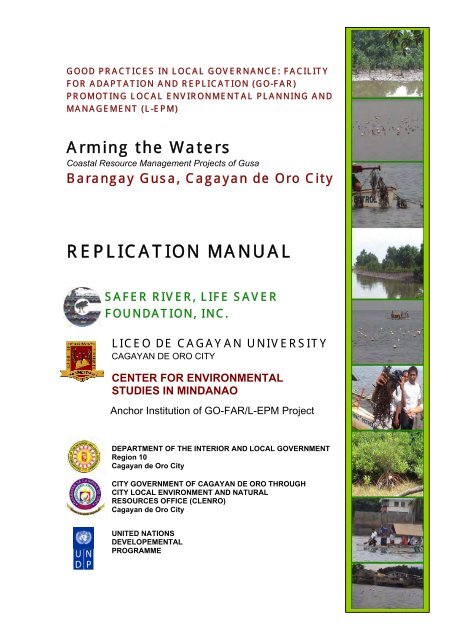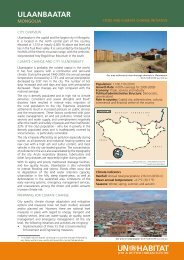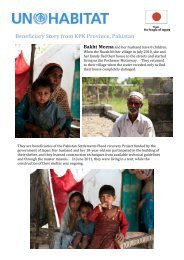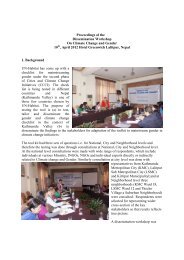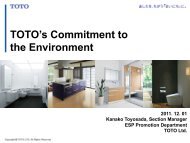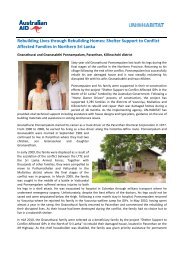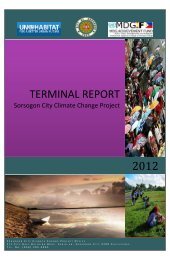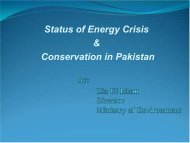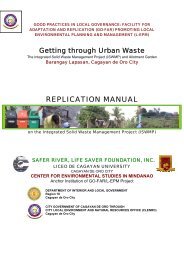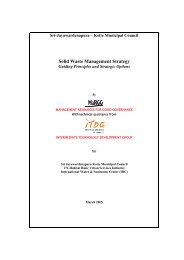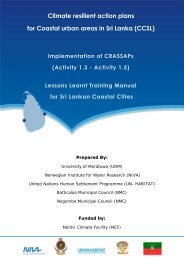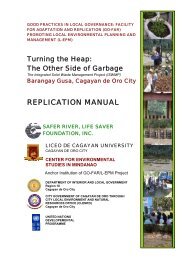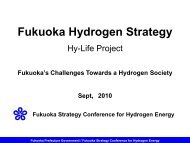Barangay Gusa, Cagayan de Oro City
Barangay Gusa, Cagayan de Oro City
Barangay Gusa, Cagayan de Oro City
You also want an ePaper? Increase the reach of your titles
YUMPU automatically turns print PDFs into web optimized ePapers that Google loves.
GOOD PRACTICES IN LOCAL GOVERNANCE: FACILITY<br />
FOR ADAPTATION AND REPLICATION (GO-FAR)<br />
PROMOTING LOCAL ENVIRONMENTAL PLANNING AND<br />
MANAGEMENT (L-EPM)<br />
Arming the Waters<br />
Coastal Resource Management Projects of <strong>Gusa</strong><br />
<strong>Barangay</strong> <strong>Gusa</strong>, <strong>Cagayan</strong> <strong>de</strong> <strong>Oro</strong> <strong>City</strong><br />
REPLICATION MANUAL<br />
SAFER RIVER, LIFE SAVER<br />
FOUNDATION, INC.<br />
LICEO DE CAGAYAN UNIVERSITY<br />
CAGAYAN DE ORO CITY<br />
CENTER FOR ENVIRONMENTAL<br />
STUDIES IN MINDANAO<br />
Anchor Institution of GO-FAR/L-EPM Project<br />
DEPARTMENT OF THE INTERIOR AND LOCAL GOVERNMENT<br />
Region 10<br />
<strong>Cagayan</strong> <strong>de</strong> <strong>Oro</strong> <strong>City</strong><br />
CITY GOVERNMENT OF CAGAYAN DE ORO THROUGH<br />
CITY LOCAL ENVIRONMENT AND NATURAL<br />
RESOURCES OFFICE (CLENRO)<br />
<strong>Cagayan</strong> <strong>de</strong> <strong>Oro</strong> <strong>City</strong><br />
UNITED NATIONS<br />
DEVELOPEMENTAL<br />
PROGRAMME
Republic of the Philippines<br />
DEPARTMENT OF THE INTERIOR AND LOCAL GOVERNMENT<br />
Region 10 - Northern Mindanao<br />
FOREWORD<br />
The Local Environmental Planning and Management Good Practices in Local Governance:<br />
Facility for Adaptation and Replication (LEPM-GO-FAR) is a project implemented by the Department<br />
of the Interior and Local Government (DILG), Liceo <strong>de</strong> <strong>Cagayan</strong> University through the Safer River,<br />
Life Saver Foundation, Inc. (SRLSF) and the <strong>City</strong> Government of <strong>Cagayan</strong> <strong>de</strong> <strong>Oro</strong> through the <strong>City</strong><br />
Local Environment and Natural Resources (CLENRO).<br />
The project is fun<strong>de</strong>d by the United Nations Development Program un<strong>de</strong>r its<br />
(UNDP-Habitad). The aim of which is to document the exemplary performance of the barangays of<br />
Lapasan, <strong>Gusa</strong> and Bugo all of <strong>Cagayan</strong> <strong>de</strong> <strong>Oro</strong> in the field of environmental planning and management.<br />
These barangays have proven that the smallest local government unit can effectively implement<br />
environmental planning and management with less support from its mother local government unit.<br />
The project intends to replicate this exemplary practice in other barangays of <strong>Cagayan</strong> <strong>de</strong> <strong>Oro</strong><br />
<strong>City</strong> by providing them the basic gui<strong>de</strong> on how to implement effective environmental planning and<br />
management at their respective areas of concern. Hence, a replication manual is <strong>de</strong>veloped by the Safer<br />
River, Life Saver Foundation, Inc. The projects presented in this replication manual are Solid Waste<br />
Management and Coastal Resource Management.<br />
The replication manual is envisioned to direct the users particularly the replicating local<br />
government unit what steps to un<strong>de</strong>rtake to effectively implement and sustain their project on Solid<br />
Waste Management and Coastal Resource Management at the barangay level. On the part of the DILG,<br />
this replication manual seeks to enhance the capacities of our field officers in providing appropriate<br />
technical assistance interventions to local government units in the area of environmental planning and<br />
management.<br />
We are confi<strong>de</strong>nt that with this replication manual, the best practices of the three barangays will<br />
proliferate in other the areas of <strong>Cagayan</strong> <strong>de</strong> <strong>Oro</strong>, Northern Mindanao and other regions for a healthy and<br />
clean environment.<br />
AUSTERE A. PANADERO<br />
Asst. Secretary for Policy Capacity Development,<br />
International Partner & Field Operations
Republic of the Philippines<br />
DEPARTMENT OF THE INTERIOR AND LOCAL GOVERNMENT<br />
Region 10, Km. 3, Upper Carmen, <strong>Cagayan</strong> <strong>de</strong> <strong>Oro</strong> <strong>City</strong><br />
Fax Nos. 723768; 858-2191 l Tel. Nos. 858-2193; 858-2192<br />
OFFICE OF THE REGIONAL DIRECTOR<br />
Message<br />
I commend the laudable efforts of the Safer River, Life Saver Foundation,<br />
Incorporated of the Liceo <strong>de</strong> <strong>Cagayan</strong> University, <strong>Cagayan</strong> <strong>de</strong> <strong>Oro</strong> <strong>City</strong>, in<br />
successfully documenting the exemplary practices on Local Environmental<br />
Planning and Management (LEPM) of <strong>Barangay</strong>s Lapasan, <strong>Gusa</strong> and Bugo, all of<br />
<strong>Cagayan</strong> <strong>de</strong> <strong>Oro</strong> <strong>City</strong>.<br />
The <strong>de</strong>velopment of this replication manual is another step forward in ensuring that<br />
local government units are given the appropriate tools as gui<strong>de</strong> in enhancing their<br />
capabilities in the implementation of national and local laws.<br />
The manual gives a <strong>de</strong>tailed procedures in implementing Solid Waste Management,<br />
Coastal Resource Management at the barangay level and how the projects were<br />
sustained by the implementing barangays.<br />
I congratulate also the <strong>City</strong> Local Environment and Natural Resources Office<br />
(CENRO) and DILG Regional Office Staff for a successful provision of technical<br />
guidance to the Safer River, Life Saver Foundation, Inc. in coming out with this<br />
replication manual.<br />
Again, Congratulations.<br />
QUIRINO M. LIBUNAO, CESO III<br />
Regional Director
LICEO DE CAGAYAN UNIVERSITY<br />
Rodolfo N. Pelaez Boulevard, Kauswagan<br />
<strong>Cagayan</strong> <strong>de</strong> <strong>Oro</strong> <strong>City</strong><br />
OFFICE OF THE PRESIDENT<br />
MESSAGE<br />
The Liceo <strong>de</strong> <strong>Cagayan</strong> University of <strong>Cagayan</strong> <strong>de</strong> <strong>Oro</strong> <strong>City</strong> is very pleased and<br />
greatly honored to have contributed to the <strong>de</strong>velopment of the modules in MASTER<br />
IN MANAGEMENT Major in ENVIRONMENTAL PLANNING AND MANAGEMENT<br />
(EPM) in the School of Graduates Studies and Good Practices in Local Governance<br />
promoting LEPM. I wish to acknowledge the contributions of the Safer River, Life<br />
Saver Foundation, Inc. and the School of Graduate Studies.<br />
This component primarily focuses on the creation of a Center of EPM Studies in<br />
Mindanao that shall serve as the repository of knowledge on EPM Process and<br />
Projects in Mindanao. The Center is expected to facilitate organizing the Local<br />
Resource Institutes (LRIs) in Mindanao to share knowledge and technologies as<br />
well as <strong>de</strong>sign new tools, curriula, and projects concerning L-EPM. In addition, the<br />
Center shall closely coordinate with the Urban Lea<strong>de</strong>rship and Management Unit<br />
(ULMU) of Local Government Aca<strong>de</strong>my (LGA) that manages information on urban<br />
<strong>de</strong>velopments and concerns, including EPM processes.<br />
In behalf of Liceo <strong>de</strong> <strong>Cagayan</strong> University, Safer River, Life Saver Foundation, Inc.<br />
the School of Graduate Studies. I commend and congratulate the Project<br />
Management Team of this en<strong>de</strong>avor for a job well done. Also, I express my thanks<br />
to the cooperating agencies, namely; the Department of Interior and Local<br />
Government through the Local Government Aca<strong>de</strong>my and the funding agency, the<br />
UN-HABITAT for all their support.<br />
To all our partners and the Project Management Team, keep up the good work.<br />
Mabuhay!<br />
DR. RAFAELITA PELAEZ-GOLEZ<br />
Presi<strong>de</strong>nt
Republic of the Philippines<br />
<strong>City</strong> of <strong>Cagayan</strong> <strong>de</strong> <strong>Oro</strong><br />
OFFICE OF THE CITY MAYOR<br />
MESSAGE<br />
As the <strong>City</strong> of <strong>Cagayan</strong> <strong>de</strong> <strong>Oro</strong> scales new and greater heights on both<br />
domestic and international fronts, we cannot and must not lose ourselves in the<br />
heady milieu of higher altitu<strong>de</strong>s. For with great progress comes the greater<br />
responsibility of maintaining the resources and circumstances that accommodates<br />
and supports our growth.<br />
Recognizing and acknowledging this symbiosis, the <strong>City</strong> Government of<br />
<strong>Cagayan</strong> <strong>de</strong> <strong>Oro</strong> works hard – singularly and in partnerships – to protect the<br />
integrity and health of the environment that breeds, feeds – and at the same time<br />
benefits from – our city’s advancement.<br />
It is heartening to know that, although we do not flaunt our efforts, they are<br />
taken note of and honored, as in the selection of <strong>Barangay</strong>s Bugo, <strong>Gusa</strong>, and<br />
Lapasan as Mo<strong>de</strong>l <strong>Barangay</strong>s in the implementation of solid waste and coastal<br />
resources management programs un<strong>de</strong>r the “Good Practices in Local Governance:<br />
Facility for Adaptation and Replication – Local Environmental Planning and<br />
Management (GOFAR-LEPM).<br />
The Replication Manual that this project aims to produce through<br />
collaboration with the city government, UN Habitat, the Department of the Interior<br />
and Local Government (DILG), the <strong>Barangay</strong> Councils concerned, and Liceo <strong>de</strong><br />
<strong>Cagayan</strong> University ‘s Safer River, Life Saver Foundation, Inc., will not only<br />
celebrate the efforts of everyone that has worked hard to achieve implementation<br />
success, but also ensure the success of future and further implementation efforts.<br />
As those of us who went before boldly went where none had successfully<br />
gone before, so now we must hold up the light and show the way to those who<br />
resolutely follow, seeking to achieve the same balance.<br />
VICENTE Y EMANO<br />
<strong>City</strong> Mayor
ACKNOWLEDGEMENTS<br />
Saving the waters of the coastal barangays of <strong>Cagayan</strong> <strong>de</strong> <strong>Oro</strong> has been<br />
among the prevailing concerns of the city government. The preeminent <strong>de</strong>pletion<br />
of coastal resources evi<strong>de</strong>nced by statistics provi<strong>de</strong>d by the BFAR is more than<br />
enough reason to set the fisherfolks of <strong>Gusa</strong> along with the L-EPM and the <strong>Gusa</strong><br />
barangay council in motion. The success of the Coastal Resource Projects of<br />
<strong>Gusa</strong> did not only prove beneficial to the fisherfolks of <strong>Gusa</strong> but the whole<br />
community itself.<br />
In the writing of this manual, the author expresses her gratitu<strong>de</strong> to the<br />
unfailing cooperation of the GUSA barangay council through the representatives<br />
in the persons of <strong>Barangay</strong> Kagawad Marlo Tabac and Ms. Teodora Carasco.<br />
Their hands-on approach since the very first parts of the process implementation<br />
up to its completion hastened the concretization of project results.<br />
Invaluable input contributed by the L-EPM managers, namely, Mr. Edwin<br />
P. Dael, Ms. Rayna Lagman, and Mr. Roscoe Masiba is also highly appreciated.<br />
Theirs was the common striving to provi<strong>de</strong> all the technical support for the project<br />
with their knowledge of the L-EPM process.<br />
The author expresses her gratitu<strong>de</strong> to the unfailing cooperation of the<br />
GUSA barangay council through the CRM committee representatives in the<br />
persons of <strong>Barangay</strong> Kagawad Marlo Tabac and Ms. Teodora Carasco.<br />
Invaluable input contributed by the L-EPM managers, namely, Mr. Edwin P. Dael,<br />
Ms. Rayna Lagman, and Mr. Roscoe Masiba is also highly appreciated. Also, the<br />
presence of GUSEAFA presi<strong>de</strong>nt Mr. Rey Galasanay during the series of<br />
interviews in the writing of this replication manual is most esteemed.<br />
Also, the presence of GUSEAFA presi<strong>de</strong>nt Mr. Rey Galasanay during the<br />
series of interviews in the writing of this replication manual is most esteemed. It is<br />
with his exemplary lea<strong>de</strong>rship in the maintenance, safekeeping, and<br />
implementation of the sanctuary policies that pushed the project to its completion.<br />
<strong>Barangay</strong> chairman Enrico Salcedo’s support in the different courses of<br />
action proposed by the working group, his open mindset to the suggestions of his<br />
constituents in the ISWM committee, and his belief in what the projects can do<br />
for the barangay is also worth noting.<br />
The stakehol<strong>de</strong>rs and partners to the project, and the concerned people of<br />
barangay <strong>Gusa</strong> are also thanked for their unwavering commitment to the CRM<br />
projects. Their faith to the greater impact of the projects for future generations is<br />
worth celebrating.
FOREWORD<br />
The implementation of the Integrated Solid Waste Management System<br />
Program in the pilot barangays of Lapasan, <strong>Gusa</strong> and Bugo in the <strong>City</strong> of<br />
<strong>Cagayan</strong> <strong>de</strong> <strong>Oro</strong> has been more than challenging and overwhelming. Proper<br />
waste disposal is a major contribution in <strong>de</strong>aling inevitable environmental issues.<br />
Promoting segregation at source will make ecological awareness climb to its<br />
peak.<br />
The realization of this documentation will afford a hope that other<br />
municipalities and cities can reflect and replicate the implementation process.<br />
Not just as a community, but such consciousness will become part of each<br />
individual’s personal values. After all there is only going to be one earth and it is<br />
everyone’s responsibility to take care of it.<br />
Dr. Rosalina S. Huerbana<br />
Project Manager<br />
GO-FAR/L-EPM Project
PREFACE<br />
Assigned the challenge of documenting the Good Practices in Local<br />
Governance: Facility for Adaptation and Replication (GO-FAR), the Safer River<br />
Life Saver Foundation, Inc. (SRLSFI), takes pri<strong>de</strong> in recording the exemplary<br />
practices of three Local Government Units (LGUs) of <strong>Cagayan</strong> <strong>de</strong> <strong>Oro</strong> <strong>City</strong>,<br />
namely, <strong>Gusa</strong>, Bugo, and Lapasan. As a private organization representing Liceo<br />
<strong>de</strong> <strong>Cagayan</strong> University’s thrust towards environmental care and preservation, the<br />
SRLSFI is partners with the Department of Interior and Local Government (DILG)<br />
and the <strong>City</strong> Government through the Local Environment Planning and<br />
Management Office (L-EPM). Its presence during the initial planning to the<br />
implementing stages of the various projects in the abovementioned LGUs<br />
therefore grant the SRLSF credibility to put their experiences in writing.<br />
This is replication manual on the Coastal Resource Management (CRM)<br />
Projects of barangay <strong>Gusa</strong>. Their challenges and the steps through which they<br />
have overcome it are recor<strong>de</strong>d herewith.
TABLE OF CONTENTS<br />
Waving By-a summary ………………………………………………………1-2<br />
Where have all the corals gone?......................................… …………….3-5<br />
Through the Sands of Time………………………………………………….5-8<br />
The Waters Give Back………………………………………………...……..8-9<br />
Stepping on the Sea Stones……………………………………………...10-14<br />
Seeing Through Clear Waters……………………………………………14-16<br />
Appendices<br />
GUSEAFA List of Officers…………………………………………………….17
1<br />
Waving by<br />
Project summary<br />
One of the most note-worthy projects facilitated by the <strong>Cagayan</strong> <strong>de</strong> <strong>Oro</strong><br />
<strong>City</strong> government through the Local Environment Planning and Management<br />
Project (LEPM) are the coastal projects of barangay <strong>Gusa</strong>. This manual is a<br />
concretization of the Good Practices in Local Governance: Facility for Adaptation<br />
and Replication (GO-FAR) goal to provi<strong>de</strong> other local government units the<br />
rudiments of successful environmental management techniques. Part of this<br />
document’s intent is to synthesize the nature of the <strong>de</strong>monstration project.<br />
Among the thirteen coastal barangays lining the east coast of <strong>Cagayan</strong> <strong>de</strong><br />
<strong>Oro</strong> <strong>City</strong>, <strong>Gusa</strong> shares the coastal waters of the Macajalar Bay. Thus, it enjoys<br />
the myriad of marine and aquatic resources that once ma<strong>de</strong> the Macajalar Bay a<br />
primary port of call during the Spanish occupation. Come present time, <strong>Gusa</strong><br />
remains as one of the main sources of fish catch in the city, along with barangays<br />
Bulua, Bayabas, Bonbon, Macabalan, Lapasan, Cugman, Tablon, Agusan,<br />
Puerto, and Bugo, supplying approximately 16, 843 MT/year. Other than the rich<br />
variety of aquatic species such as octopus, milkfish, goatfish, butterfly fish, and<br />
white shrimp, the city’s coastal and marine ecosystems provi<strong>de</strong> resources such<br />
as mangroves, coral reefs, beach sand, and sea grass beds.<br />
Of three mo<strong>de</strong>l barangays chosen<br />
for the Local Environment Planning and<br />
Management Project (L-EPM), the local<br />
government of <strong>Gusa</strong> was i<strong>de</strong>ntified for<br />
coastal projects which inclu<strong>de</strong> a fish<br />
sanctuary, artificial coral reefs, and<br />
mangrove reforestation. Upon the<br />
suggestion of the Bureau of Fisheries and<br />
Aquatic Resources (BFAR), the fisherfolks<br />
in the area consi<strong>de</strong>red the suitability of<br />
LOOKING FOR SANCTUARY LOCATION<br />
their immediate environment to the<br />
projects. Although there is no <strong>de</strong>nying the<br />
richness of the <strong>Gusa</strong> coasts, years of dynamite fishing are taking its toll on their<br />
corals, thus, the reduced volume of catch. In the years past, the safety of the<br />
coral reefs in <strong>Gusa</strong> was not protected by any strictly enforced law against illegal<br />
fishing. The need to repair impending <strong>de</strong>struction of the corals and refurbish the<br />
benefits the coasts exten<strong>de</strong>d the fishermen became top priorities.<br />
Accordingly, a series of meetings to plan the program activities was held<br />
among the fisherfolks organized as the <strong>Gusa</strong> Seasi<strong>de</strong> Fisherfolks Association<br />
(GUSEAFA). Linkages were also ma<strong>de</strong> with national agencies. Technical<br />
assistance was provi<strong>de</strong>d for by the city agriculture office who is primary partners
2<br />
with the fisherfolks association and the local government unit. Project priorities<br />
and concerns, an implementation scheme, and sources for funds were singled<br />
out as well.<br />
Early in 2003, a fish sanctuary with artificial reefing was at ready hand to<br />
serve the project objectives. The 8.6 hectare sanctuary remains within the 30%<br />
allowable coastal area in terms of Maritime and Fishery Laws provisions. A<br />
floating guard is maintained around the area to keep secure the sanctuary.<br />
Concrete pyramid corals, 43 of which are lodged within the perimeters which are<br />
also marked by stryopore balls. A mangrove reforestation project was later tested<br />
in the coastal waters. Though strong currents failed it initially, the working group<br />
found a more strategic location. Eventually, they <strong>de</strong>ci<strong>de</strong>d to try planting the<br />
seedlings along the creek area.<br />
In coordination with the working<br />
group of another L-EPM offshoot<br />
project, the <strong>Gusa</strong> Integrated Solid<br />
Waste Management Program<br />
(ISWMP), the CRM held a monthly<br />
clean-up drive. With community<br />
participation, an efficient working<br />
group, and the support of the<br />
barangay council, the project held up<br />
to its maximum and beneficent<br />
capacity <strong>de</strong>spite the breakdown in the<br />
organization in 2004. Still, with a few<br />
able and committed members, the<br />
project was sustained. A snap<br />
LOCATING AREA FOR MANGROVE<br />
PLANTATION<br />
election and three presi<strong>de</strong>nts later, the <strong>Gusa</strong> CRM found renewed strength<br />
through the lea<strong>de</strong>rship of one who has been with the project as member from the<br />
very start. Such is proof to tell that a committed working group is a project’s best<br />
asset.<br />
Presently, the <strong>Gusa</strong> fish sanctuary remains to be the largest and most<br />
sustainable among others put up in the coastal barangays. Only a year after the<br />
project was implemented, concrete results already inclu<strong>de</strong> an increased fish<br />
catch around the sanctuary area. Variants of the species already present in the<br />
area appeared superior and more numerous than they were before the project.<br />
This of course, was to the benefit of the locals who took their living off the sea.<br />
More importantly, the project is barangay <strong>Gusa</strong>’s contribution to restoring the<br />
glory of the marine ecosystem that witnessed the growth of <strong>Cagayan</strong> <strong>de</strong> <strong>Oro</strong> as a<br />
city.
3<br />
Where have all the corals gone?<br />
<strong>Gusa</strong> Coasts Profiled<br />
This section aims to provi<strong>de</strong> a profile of the project location, rationale,<br />
objectives, and results. This is particularly helpful for the replicator to discover<br />
applicability of the <strong>Gusa</strong> CRM projects in addressing his own locale’s<br />
environmental management issues.<br />
Depletion in the volume of fish catch in most recent years has been<br />
observed. Overall statistics gathered from the L-EPM Office (BFAR,1997) shows<br />
that the average fish catch of certain fishermen more than halved from .63 kg. /hr.<br />
in the early 90’s to .24 kg. /hr in 1999. The culprits to the situation are siltation,<br />
direct extraction, and illegal fishing activities like blast fishing, use of poison-like<br />
cyani<strong>de</strong>, and electro fishing among several others. Severely mitigating the case<br />
are inappropriate and illegal mangrove conversion, intrusion of Commercial<br />
Fishing Boats (CFB’s) within 15 kms of the waters and the careless <strong>de</strong>position of<br />
wastes into the seawaters have contributed to the further <strong>de</strong>pletion of marine<br />
resources.<br />
More so, the garbage situation is extremely <strong>de</strong>teriorated due to heavy<br />
population of people who frequent the beaches during the weekend. Because of<br />
this, coliforms have reached levels higher than the tolerable 1000 ppm/100 ml to<br />
a range of 4000 to 33000.<br />
The Bantay Dagat Association of the <strong>City</strong> recognized the state of the seas<br />
including that in <strong>Gusa</strong> and others. As one of the stakehol<strong>de</strong>rs, it lobbied for<br />
issues like marine preservation and reef restoration and spearhea<strong>de</strong>d information<br />
campaign activities to educate and instill awareness among the future<br />
stakehol<strong>de</strong>rs on the protection of marine life. Despite promulgation of Maritime<br />
and Fishery Laws, ina<strong>de</strong>quate enforcement still leaves a lot of room for<br />
constraints that they had to face up to. These problems inclu<strong>de</strong> the following:<br />
‣ Insufficient equipment and personnel to enforce regulations,<br />
‣ Insufficient operational budget/logistic support for enforcement<br />
activities,<br />
‣ Loose political will by the government and stakehol<strong>de</strong>rs to enforce<br />
the laws,<br />
‣ Not enough cooperation/coordination among the LGU and<br />
concerned agencies,<br />
‣ Lack of complementarities in the municipal ordinances along<br />
Macajalar Bay, and<br />
‣ No policy/ordinance anchored on a National Law to prosecute<br />
polluters and illegal fishers
4<br />
Before these constraints, the association nee<strong>de</strong>d to intervene. The current<br />
status of the coastal sector is evi<strong>de</strong>nce of an alarming <strong>de</strong>gradation of the city’s<br />
coastal and marine resources. If livelihood of the fisherfolks is to be sustained,<br />
then it is a must to protect, rehabilitate, and conserve the coastal marine system.<br />
Otherwise, the continued <strong>de</strong>struction of it could endanger the health of the<br />
people in the area and worsen the economic situation of the fisherfolks.<br />
The coastal <strong>Barangay</strong> of <strong>Gusa</strong> is not far removed from the situation of the<br />
city’s coastal waters. Similarly, dynamites and fish gears used by the local<br />
fisherfolks reduced the fish stock in the territorial waters. Mangroves were<br />
illegally cut-off by inconsi<strong>de</strong>rate locales thereby severing reproduction before it<br />
even starts.<br />
It was exactly these hard-pressing dangers that prompted the GUSEAFA<br />
with the L-EPM, BFAR, the aca<strong>de</strong>mes, LGU, POs, and the community to i<strong>de</strong>ntify<br />
the CRM project to the coastal area of <strong>Gusa</strong>. Although the area could not be any<br />
more suited to it, the fisherfolks did not immediately extend their involvement.<br />
Initially, an instant concern is the probable effect of the sanctuary to their<br />
livelihood. Although no instant threat is foreseen by the breadth of the sanctuary<br />
area as there was wi<strong>de</strong> enough space to fish, the fisherfolks were adamant to the<br />
thought of volunteering without compensation. However, proper convincing<br />
through meetings and orientations ma<strong>de</strong> them realize the advantages that await<br />
them in the future if the coral reefs be fully restored. Thus, the following solutions<br />
were recommen<strong>de</strong>d:<br />
‣ Strict Implementation of Maritime and Fishery Laws,<br />
‣ Provision of appropriate funding for enforcement activities and the<br />
acquisition of facilities and equipment,<br />
‣ Creation of fisheries division office and <strong>de</strong>ployment of additional<br />
fishery technical personnel in the barangay level<br />
‣ Extensive information drive through dialogues and the mass media,<br />
‣ Strengthening of a regular coastal clean-up drive,<br />
‣ Continuous skills training and seminars for fisherfolks organizations,<br />
‣ Establishment of fish sanctuaries and addition of floating guard<br />
houses<br />
‣ Mangrove reforestation campaign,<br />
‣ Participation of the GUESEAFA in the drafting and approval of<br />
unified local fishery ordinances within Macajalar Bay<br />
‣ Provision of alternative livelihood projects for fisherfolks,<br />
‣ Strengthening of regular monitoring, control and surveillance of<br />
coastal and marine areas,<br />
‣ Establishment of fisherfolks villages along the coastal waters of<br />
CDO<br />
‣ Establishment of a Fishery Division or Section in the city<br />
government un<strong>de</strong>r the city agriculture office
5<br />
After securing the cooperation of the fishing community, the stakehol<strong>de</strong>rs<br />
and working group were bent at <strong>de</strong>veloping the project objectives to<br />
‣ preserve marine resources<br />
‣ increase the fish catch of fisherfolks<br />
‣ rehabilitate/reforest the marine ecosystem<br />
All of which were accomplished through the fish sanctuary, an 8.6 hectare<br />
area chosen for its undisturbed environment, consi<strong>de</strong>rable distance from<br />
households, and mild nature of its currents. The sanctuary houses 43 units of<br />
concrete pyramid corals Orientations for the people also i<strong>de</strong>ntified for them the<br />
endangered state of their marine life. Support for the project was obtained and<br />
sustained through regular meetings and planning sessions, information drives,<br />
and clean-up activities. In 2004, a mangrove plantation was already set up along<br />
the creeks of <strong>Gusa</strong>. Sustaining these projects through and through is clearly in<br />
the collective consciousness of the project implementers.<br />
Through the Sands of Time<br />
Project History<br />
The means through which the working group and stakehol<strong>de</strong>rs were urged<br />
to address the coastal water situations are worth mentioning. Environmental<br />
concern and political will played large parts in the implementation of the projects<br />
on coastal resource management by the LGU of <strong>Gusa</strong>; the initial steps which<br />
eventually led to material results are recounted in the brief history below.<br />
The project was initiated by the L-EPM project in coordination with the<br />
<strong>Barangay</strong> council and the GUSEAFA. Before the project implementation on<br />
March 3, 2001, activities were planned and programmed during meetings among<br />
the fisherfolks. Discussions and <strong>de</strong>cisions were ma<strong>de</strong> on the priorities and<br />
concerns of the coastal marine sectors. Talk was focused on improper disposal<br />
of domestic/commercial waste and the ineffective anti-pollution <strong>de</strong>vices of<br />
industries. This is a contributory factor to the <strong>de</strong>gradation of coastal marine<br />
habitats and <strong>de</strong>pletion of marine resources.<br />
Another issue the meeting group addressed was the poor socio-political<br />
and environmental direction that resulted to unequal distribution of economic<br />
opportunities, particularly prevalent poverty among the fisherfolks. Talk also<br />
centered on the lack or ineffective public information drive for the protection and<br />
conservation of marine life. This was primary factor to the resistance from<br />
volunteer work that was initially observed among the people. The enforcement of<br />
maritime and fishery laws for coastal protection, conservation and rehabilitation<br />
was also i<strong>de</strong>ntified.
6<br />
THE MANGROVE PLANTATION<br />
Consequent to the planning<br />
stage, linkages were also ma<strong>de</strong> with<br />
national agencies for technical<br />
assistance. In coordination with the<br />
barangay council, the Fisheries<br />
Sector of the L-EPM tapped the<br />
BFAR and the <strong>City</strong> Administrator’s<br />
office. As a result of the prioritization<br />
of environmental issues, these<br />
agencies were i<strong>de</strong>ntified as most<br />
suited to the project CRM. From the<br />
aca<strong>de</strong>me, the Xavier University<br />
Marine Biology Department also<br />
ai<strong>de</strong>d the stakehol<strong>de</strong>rs in i<strong>de</strong>ntifying<br />
the sanctuary location.<br />
Based on the strengths of the immediate community, in terms of people<br />
participation and the organization among its fisherfolks, a location for the<br />
sanctuary was i<strong>de</strong>ntified. The spot was chosen since it was the least disturbed by<br />
strong currents, farthest from the barangay’s resi<strong>de</strong>ntial area but only business<br />
establishments. Having studied the sanctuary location of a neighboring coastal<br />
barangay Lapasan, the stakehol<strong>de</strong>rs knew better than to build a sanctuary that is<br />
proximal to people. As in the case of Lapasan, a trail was built towards the area<br />
for fishing boats which disturbed the peace of the sanctuary.<br />
The choice of location was further consulted with the <strong>City</strong> Planning Office<br />
by the L-EPM. This was in or<strong>de</strong>r to align the sanctuary with the city <strong>de</strong>velopment<br />
plans. The working group found out that plans for <strong>de</strong>velopment have been laid<br />
out up to Lapasan. <strong>Gusa</strong> comes only right after Lapasan and so it does not<br />
overlap with anything that the city planned for. Finally, the XU Marine Biology<br />
Department and the BFAR confirmed the location as strategic. Basically, they<br />
consi<strong>de</strong>red the observed <strong>de</strong>pletion of the fisherfolks’ catch which has been<br />
reduced to less than half what they usually caught. From this was formulated the<br />
objective to rehabilitate and preserve the marine resources of coastal <strong>Gusa</strong>.<br />
Project implementation started on March 3, 2001. Already, a strong<br />
association of fisherfolks has been manning the preparations for implementation.<br />
The fish sanctuary was handled just as efficiently by the GUSEAFA who<br />
distributed the tasks of maintenance like taking charge of the floating guard,<br />
among themselves. The floating guard, raft-like equipment with barrels and silver<br />
sheeting as floaters, was acquired through the BFAR. Maintaining the sanctuary<br />
equipment was also handled by the GUSEAFA members. Styropore markers<br />
were routinely checked for security. Forty three units of concrete pyramid corals<br />
were also dropped to the sanctuary bottom. Each one was carried out to sea on<br />
two rafts which were parted in the middle to drop the pyramids. This was done so
7<br />
the artificial corals would drop with its pyramid base flat on the ground. This<br />
method was borne from one near-acci<strong>de</strong>nt.<br />
At one time, the members floated the corals out to sea on one raft. They<br />
were to drop the pyramid onto one si<strong>de</strong> of the raft and into the sanctuary when<br />
the raft lost its balance and almost toppled over. The artificial reef was dropped<br />
and one of the men was brought along by the weight. The sanctuary was at a<br />
<strong>de</strong>ep end of the <strong>Gusa</strong> coasts and he would have easily drowned. Apparently, a<br />
part of his clothing was stuck to the pyramid and so the mishap. Had not the<br />
members dived to his rescue, the GUSEAFA would have lost one man.<br />
Simultaneous with the <strong>de</strong>velopment and maintenance of the fish sanctuary<br />
was the cultured guso the GUSEAFA started out at the sanctuary. Though the<br />
business proved to be very lucrative, the project implementation required the<br />
members to be on call for the recoreda, clean-up drives, meetings, and other<br />
activities that responsibility for the business could not be taken by anybody<br />
anymore until much later.<br />
PROJECT PARTNERS-THE SRLSFI AND<br />
BRGY. COUNCIL REP’S<br />
A year later, a mangrove<br />
plantation was carried out in August<br />
27, 2002. The GUSEAFA presi<strong>de</strong>nt at<br />
that time atten<strong>de</strong>d a seminar in<br />
Osamis <strong>City</strong> on the proper growth of<br />
mangroves. The working group first<br />
attempted to plant the seedlings in the<br />
sanctuary. However, the bamboo<br />
railings were not strong enough<br />
against the currents. The seedlings<br />
were washed off and caused the<br />
group a major loss. Eventually, the<br />
fisherfolks found a new location along<br />
the creeks of the area. This new<br />
mangrove plantation flourished and now serves both the neighborhood along the<br />
creeks as protection from floods.<br />
Throughout the implementation of these coastal projects, the <strong>Gusa</strong> CRMP<br />
was hand in hand the <strong>Gusa</strong> ISWMP in the information and clean-up drives. Loud<br />
speakers in the garbage trucks were installed to increase awareness among the<br />
households who contribute to 70% of the refuse that find its way into the marine<br />
sector. In support of the ISWMP, wastes gathered in the monthly clean-ups are<br />
automatically segregated and the bio<strong>de</strong>gradable ones sent to the ISWMP<br />
Materials Recovery Facility (MRF).<br />
In 2004, the GUSEAFA partially disintegrated to the <strong>de</strong>triment of the<br />
projects. Despite this, the members maintained their coordination and meetings<br />
with various stakehol<strong>de</strong>rs were kept up. Dwindling interest and changing of<br />
priorities among some of the members might have affected the association, but it
8<br />
did not impair the sanctuary and mangrove plantations. A number of the original<br />
members <strong>de</strong>ci<strong>de</strong>d to keep up with the sanctuary maintenance to the best they<br />
can. In several instances, the sanctuary guards were compelled to pool in their<br />
own individual compensation of PhP 150.00 from the city government to make<br />
manageable repairs in the floating guard or the sanctuary markers.<br />
A change of presi<strong>de</strong>nt in 2004 was what the project nee<strong>de</strong>d to restore the<br />
level of accomplishment it had for the past years. Effective rapport with the<br />
members was restored within the association. A new ordinance to attain the<br />
project objectives was drafted, passed, and approved by the city government.<br />
With the project results, the <strong>Gusa</strong> coastal resource projects are in<strong>de</strong>ed worthy of<br />
replication in other coastal barangays in the city.<br />
The Waters Give Back<br />
Project Results<br />
In four year’s time, the fish sanctuary and artificial reef projects show<br />
positive results that go beyond the group’s expectations. Marine life preservation<br />
was initially hinted by the visibility of fish within the sanctuary and surrounding<br />
areas. The implementers could not contain their excitement about the abundance<br />
of fish everywhere. “Dili gyud manghawa ang mga isda bisan naa ra mi sa dool!”<br />
(The fish won’t go anywhere even if we were nearby!) Having been oriented<br />
about the advantages of keeping fish safe to propagate in a sanctuary, the<br />
GUSEAFA presi<strong>de</strong>nt explained this <strong>de</strong>velopment with a comparison. He said fish<br />
are like people. In as much as people stay away from unsafe environment, so do<br />
marine animals. Fish like people, stay where they are unharmed and at peace.<br />
This is owed by the commitment of all GUSEAFA members to the cause<br />
of preserving their source of livelihood. The formal coming together of their fellow<br />
fisherfolks also encouraged them to contribute their services to guarding the<br />
corals from external constraints. A year after the realization of the sanctuary, the<br />
fisherfolks cast their nets just outsi<strong>de</strong> the sanctuary perimeters. Though fish are<br />
kept safe within the sanctuary, they are free to come and go beyond the area.<br />
For their first catch, the fisherfolks caught large varieties of bagis weighing<br />
around 3 kilos each. The barracudas they netted were, in their own words, “dako<br />
pa sa tawo!” (Bigger than a grown person!”)<br />
Another indicator to the improved variety is the increased volume of fish<br />
catch. Before the sanctuary was created, the fisherfolks experienced slow days<br />
when there is very little or no catch at all. “Kulob gyud ang kal<strong>de</strong>ro usahay.”<br />
(Literally, there’s simply nothing to place in our pots day to day.) In contrast, with<br />
sanctuary and artificial corals set-up, the fisherfolks never beached with nothing.<br />
In other words, fish catch average to 10 kilos every day. In addition, new recruits<br />
of precious and semi-precious corals also existed where there used to be none.
9<br />
Positive results were also evi<strong>de</strong>nt in the mangrove plantation. Well-rooted<br />
since the reforestation, the mangroves along the creek were nested with birds.<br />
Crabs and seashells can also be found in the area. Most especially, erosion<br />
along the banks has also been prevented.<br />
In the beginning, the community<br />
people showed apprehensions<br />
regarding the proposed sanctuary<br />
project. They felt threatened by the i<strong>de</strong>a<br />
of a preserved part of the waters that<br />
might lessen their usual catch. The<br />
coastal resource projects however, with<br />
the full support of the barangay council<br />
and the L-EPM partners, ma<strong>de</strong><br />
attitudinal change possible. Information,<br />
Education, and Communication GUSO IN THE SANCTUARY<br />
campaign activities which inclu<strong>de</strong>d<br />
barangay level meetings evoked certain <strong>de</strong>grees of environmental<br />
consciousness among the people. Since then, the community has become more<br />
organized and involved in the project activities. An organization was organized<br />
among all the five cluster presi<strong>de</strong>nts of purok 5. Due this, mobilization of project<br />
partners and stakehol<strong>de</strong>rs especially in outsourcing for project funds, was more<br />
convenient.<br />
Most importantly, the impact of the project encompasses environmental,<br />
social, and economic aspects. In the increased monitoring and clean-up activities<br />
that have become part of the community’s culture, the fisherfolks are more<br />
assured of their livelihood. Other than that, although coastal <strong>Gusa</strong> is only a spot<br />
consi<strong>de</strong>ring the long stretch of the Macajalar Bay, its contribution to preserving<br />
marine life and keeping the beach clean cannot be taken for granted.<br />
Rejuvenated coastal resources: increased fish<br />
catch and new variants of corals<br />
Built-up capabilities among project<br />
team members<br />
Collective concern and effort to preserve the<br />
coasts among fisherfolks and locals<br />
Alternative income through cultured guso<br />
GUSA<br />
CRM<br />
Clean and healthy coastal environment<br />
Reforested mangrove area<br />
Improved relations between baranggay council<br />
and constituents<br />
Figure 1. Fruits of their Labor: Visible Results of the CRM projects
10<br />
Stepping on the Sea Stones: The Key Implementation Steps<br />
<strong>City</strong> level activities prece<strong>de</strong>d the implementation of the CRM.<br />
Participation of<br />
LGU<br />
representatices<br />
to<br />
L-EPM process<br />
Consultation<br />
with potential<br />
project<br />
stakehol<strong>de</strong>rs<br />
I<strong>de</strong>ntification of<br />
environmental<br />
issues and<br />
appropriate<br />
project<br />
Setting up an<br />
organizational<br />
structure for<br />
the project<br />
team<br />
Figure 2. Preliminary Steps to the CRM<br />
The working group and stakehol<strong>de</strong>rs, familiar with strategies and<br />
techniques provi<strong>de</strong>d for by the L-EPM, went through a six-fold agenda to meet<br />
the project goals. The following are key implementation steps to the <strong>Gusa</strong> CRM.<br />
I. Mission Preparations<br />
‣ I<strong>de</strong>ntify barangay environmental problems with the L-EPM and<br />
other possible stakehol<strong>de</strong>rs.<br />
In 1999, four community organizers with the LGU of <strong>Gusa</strong><br />
participated in the seminar workshop organized by the L-EPM unit<br />
un<strong>de</strong>r the city government in partnership with the CLENRO as<br />
future stakehol<strong>de</strong>rs of the EPM methodology, the organizers were<br />
given an orientation briefing. Issues and concerns were i<strong>de</strong>ntified in<br />
their barangay. The EPM Fisheries Sector through the BFAR<br />
became primary partner agency to the coastal barangay of <strong>Gusa</strong>.<br />
‣ I<strong>de</strong>ntify and organize members for a working group.<br />
A core group of organizers was i<strong>de</strong>ntified among the fisherfolks of<br />
the barangay. The GUSEAFA was formed to serve the purpose of a<br />
working group to implement the coastal projects.<br />
MORE AREA SURVEILLANCE
11<br />
‣ Evaluate a sanctuary location based on certain criteria.<br />
An evaluation of the coastal area was ma<strong>de</strong>. Upon the<br />
recommendation of the BFAR and the XU Marine Biology<br />
Department, an 8.6 hectare location was i<strong>de</strong>ntified based on<br />
specific criteria.<br />
‣ Consult the <strong>City</strong> Planning Office before implementing the projects.<br />
The L-EPM staff and the GUSEAFA consulted the <strong>City</strong> Planning<br />
Office to align the project specifics to city-wi<strong>de</strong> plans.<br />
‣ Plan for actions and strategies for project implementation.<br />
Upon approval, the barangay council, L-EPM staff and the i<strong>de</strong>ntified<br />
core group of organizers held an action and strategy planning for<br />
the CRM projects.<br />
‣ Delegate specific tasks among working group members.<br />
GUSEAFA members were assigned specific tasks as war<strong>de</strong>n,<br />
maintenance men and others in the sanctuary and artificial reefing<br />
projects.<br />
I<strong>de</strong>ntified options to resolve by working group<br />
Environmental<br />
Issue: Coastal<br />
Resource<br />
Depleiton<br />
Technical and financial aid from project partners<br />
Detailed action plan drafted by project team (WG and stakehol<strong>de</strong>rs)<br />
Figure 3. Immediate Actions Taken on CRM<br />
2. Information, Education and Communication<br />
‣ Hold extensive recoreda and IEC.<br />
The CRM project work group tied up with the ISWMP IEC activities.<br />
Word on the project cause and objectives were announced through<br />
recoreda amplifiers in the garbage collection trucks.
12<br />
‣ Send work group members to trainings and seminars.<br />
Technical trainings and workshops were held for the working group<br />
to equip them with the necessary skills in maintaining the<br />
sanctuary.<br />
‣ Hold echo seminars throughout the immediate areas of the<br />
projects.<br />
Information drive was strengthened and sustained through the<br />
organization of cluster presi<strong>de</strong>nts. Led by the GUSEAFA,<br />
consultation and orientation seminars were re echoed to the<br />
different puroks along the coastal areas.<br />
3. Financial and Equipment Acquisition<br />
‣ Tap project partners for financial and material support.<br />
The L-EPM coordinated with the LGU for financial support on the<br />
project implementation. The BFAR was also tapped for the<br />
technology and materials to sustain the project. Honorarium and<br />
financial assistance was provi<strong>de</strong>d by the city government for the<br />
nine caretakers of the different projects.<br />
‣ Acquire basic security equipments and facilities for the project staff.<br />
A floating guard and patrol boat were purchased for the sanctuary.<br />
GUSEAFA members were also equipped with rubber boots and<br />
raincoats. Project supplies were also acquired like flashlights,<br />
batteries, rakes, and shovels.<br />
‣ Improve physical<br />
infrastructures of the project.<br />
A meeting hall was<br />
renovated for the core group.<br />
Simultaneously, a footbridge to<br />
the mangroves area was also<br />
constructed.<br />
4. Sanctuary Construction, Protection, and Maintenance<br />
‣ Prepare i<strong>de</strong>ntified location for the project.<br />
GUARDIANS OF THE SEA
13<br />
A clean-up of the i<strong>de</strong>ntified location and the surrounding area is<br />
done. Garbage at the sanctuary bottom is picked by divers to<br />
prepare the bottom for artificial reefing.<br />
‣ Mark the sanctuary peripheries.<br />
With the sanctuary location i<strong>de</strong>ntified and the necessary materials<br />
at ready hand, the GUSEAFA marked the sanctuary bor<strong>de</strong>rs with<br />
styropore balls.<br />
‣ Place artificial reefs in the sanctuary bottom.<br />
Forty three units of concrete pyramid corals were dropped into the<br />
bottom. Two rafts were held together in the middle and pulled apart<br />
to sink the artificial reefs.<br />
‣ Station security persons in the sanctuary.<br />
The implementers worked out a schedule for alternating stations at<br />
the floating guard. At times, the project partners like the barangay<br />
council representatives took time to enjoy the placid waters while<br />
monitoring the sanctuary.<br />
‣ Make use of sanctuary area to culture seaweeds for additional<br />
income.<br />
The association also started culturing guso within the sanctuary. It<br />
was lucrative business however; priorities of the GUSEAFA<br />
members did not allow room to handle the business. It was<br />
discontinued but later on revived as a family business.<br />
‣ Pass an ordinance to protect the project cause.<br />
To remedy the random cases of illegal fishing, barangay ordinance<br />
Ordinance No. 2001-06-02 was passed. It is stipulated in the<br />
ordinance that fishing, bathing, or the passing of motor boats are<br />
sanctioned with a PhP 50.00, PhP 100.00, and PhP 200.00<br />
penalties for the first, second, and third offenses. Previous to this<br />
was another ordinance that only sanctioned a first violator with<br />
PhP 500.00 per 25 kilos of his illegal catch. The old ordinance also<br />
did not require that the fish be surren<strong>de</strong>red to <strong>Gusa</strong>. It was exactly<br />
this loose sanction that the new ordinance tried to prevent.
14<br />
5. Mangrove Plantation and Maintenance<br />
‣ Earn technical knowledge and skills in mangrove plantation.<br />
The GUSEAFA presi<strong>de</strong>nt atten<strong>de</strong>d a seminar on mangrove<br />
plantation in Osamis <strong>City</strong> for a carry-over of input learned to the<br />
coastal barangay of <strong>Gusa</strong>.<br />
‣ Find a suitable location for mangrove reforestation.<br />
The implementers tested the mangrove seedlings insi<strong>de</strong> the<br />
sanctuary with bamboos. However, the attempt failed due to the<br />
strong un<strong>de</strong>rwater currents. They had to look for another location<br />
and <strong>de</strong>ci<strong>de</strong>d on a shrubby creek area. Another clean up ensued<br />
before the new seedlings were put in place. Carelessly uprooted<br />
or cut by some locales, what’s left of the old mangroves were taken<br />
away and replaced by new ones.<br />
6. Projects Sustainability<br />
‣ Uphold schedule of regular meetings, maintain clean-up activities,<br />
and coordinate with project partners.<br />
Meetings are still held on a regular basis. The monthly clean-up<br />
involves the community by taking volunteers for the diving and sack<br />
clothing of the creeks, rivers, and the sea. Coordination with the<br />
project partners is constant especially with the hands-on approach<br />
of the L-EPM and the <strong>City</strong> Agriculture Office.<br />
Seeing Through Clear Waters<br />
The implementers have as much to say about the importance of<br />
cooperation in a group and more to say about how years of hard work can be<br />
<strong>de</strong>stroyed by a single pursuance of personal interest. In years past, the<br />
GUSEAFA has had more presi<strong>de</strong>nts than any organization might have in one<br />
year. The varying <strong>de</strong>grees of commitment the members started out with did not<br />
particularly sustain the group through the tough times. The group actually went<br />
<strong>de</strong>funct in 2004.<br />
During this time, the old GUSEAFA presi<strong>de</strong>nt quit his post to work as an<br />
employee at the <strong>City</strong> Agriculture Office. While he has just taken his<br />
responsibilities to the environment a step up, some of his former mates in the<br />
association were feeling left out. This <strong>de</strong>velopment caused some of the original<br />
members to withdraw their support. Even with a new presi<strong>de</strong>nt, the group
15<br />
steadily fell apart. There was no rapport among the members and attendance to<br />
meetings was the worst.<br />
Only recently did the implementers learn the value of selflessness un<strong>de</strong>r a<br />
new lea<strong>de</strong>rship. It was their present presi<strong>de</strong>nt’s initiative to stop expecting a large<br />
payback and just do what should be done for the good of the projects. At times,<br />
minor repairs had to be done in the sanctuary. Immediately, instead of waiting for<br />
outsi<strong>de</strong> funding, they pool in their own resources and get things done. Thus, the<br />
members learned the values of commitment and self-sufficiency.<br />
Firm rule and law abidance<br />
Fully-operative fish sanctuary<br />
Overall<br />
Ecological Concern<br />
Strong Political Will<br />
Effective Information Drive<br />
Heartfelt commitment<br />
Figure 4. Elements of Survival: Core Values of a Successful CRM<br />
Further, the group realized the need for a sufficient financial support to<br />
ensure project sustainability. Funding from the city government was extant but<br />
could not really cover all the expenses of the activities. As a solution, the group<br />
solicited financial aids from the many business establishments near the area.<br />
Volunteerism was also an option they found useful. Coastal clean-up and project<br />
monitoring were done by community people with the project implementers.<br />
Maintenance activities were shared by the direct beneficiaries themselves.<br />
They also learned how projects like this one should be appropriately<br />
budgeted. In year 2000, artificial coral reefs and styropore balls alone cost PhP<br />
150, 000. In the next years, with the purchase of a floating guard and other<br />
additional equipments, project cost ran a total of PhP 300,000. Technical<br />
planning is also necessary so to avoid mistakes like their first attempt with the<br />
mangrove plantation. The financial liability it entailed was more than any LGU<br />
can afford. Fortunately, the technical support provi<strong>de</strong>d by the BFAR was<br />
sufficient and allowed the implementers to correct their errors.<br />
Another valuable lesson that the project taught the implementers is a<br />
change in their fishing methods. Because of their attitudinal change towards the<br />
environment, the fisherfolks are more conscious of correct fishing methods,<br />
careful not to ruin the chances of the fish stock surviving in the sanctuary.
16<br />
Within the GUSEAFA, the project gave the fisherfolks a better<br />
un<strong>de</strong>rstanding and appreciation of the sea from whence they take their bread<br />
and butter. A certain level of diplomacy has also <strong>de</strong>veloped in their <strong>de</strong>alings with<br />
each other. In other words, the fisherfolks grew in terms of attitu<strong>de</strong> and<br />
perspective through the association.<br />
Overall, the <strong>Gusa</strong> CRM projects are worthy of replication especially<br />
among the neighboring coastal barangays in the city. A key factor that allowed<br />
<strong>Gusa</strong> their successes is the tight-knit society of fisherfolks called GUSEAFA. The<br />
organization, <strong>de</strong>spite its pitfalls in the last two years, basically worked as a<br />
working group because theirs is a concern for the sea which is also their<br />
livelihood. If the CRM projects be replicated in other LGU’s, a society of<br />
fisherfolks has to be organized first and foremost.
17<br />
Appendix A<br />
GUSEAFA Officers<br />
Presi<strong>de</strong>nt:<br />
Vice Presi<strong>de</strong>nt:<br />
Treasurer:<br />
Secretary:<br />
Auditor:<br />
P.I.O.<br />
Board Members:<br />
Members:<br />
Rey Galasanay<br />
Alipio Ballentos<br />
Lino Alba<br />
Christopher Durban<br />
Everet Cirus<br />
Carlito Mahinay<br />
Pablo Monilar<br />
Diosdado Durban<br />
Sergio Durban<br />
Pepi Torion<br />
Celso Ca<strong>de</strong>rao<br />
Narciso Iyana<br />
Allan Sabellano<br />
Err Oser<br />
Danny Lim<br />
Nanding Cabalda<br />
Jaime Pilo<br />
Pablio Hinayon
GO-FAR/L-EPM PROJECT MANAGEMENT TEAM<br />
DR. ROSALINA S. HUERBANA<br />
Executive Director<br />
Safer River, Life Saver Foundation, Inc.<br />
Liceo <strong>de</strong> <strong>Cagayan</strong> University<br />
<strong>Cagayan</strong> <strong>de</strong> <strong>Oro</strong> <strong>City</strong><br />
MR. QUIRINO M. LIBUNAO<br />
Regional Director<br />
Department of Interior and Local Government (DILG)<br />
Region X<br />
<strong>Cagayan</strong> <strong>de</strong> <strong>Oro</strong> <strong>City</strong><br />
MS. ZAIDA TAN NERY<br />
CLENRO Designate<br />
<strong>City</strong> Local Environment and Natural Resources Office<br />
<strong>City</strong> Government of <strong>Cagayan</strong> <strong>de</strong> <strong>Oro</strong><br />
<strong>Cagayan</strong> <strong>de</strong> <strong>Oro</strong> <strong>City</strong><br />
GO-FAR/L-EPM PROJECT DOCUMENTATION TEAM<br />
DR. ROSALINA S. HUERBANA<br />
Project Manager<br />
ENGR. MARISIA C. NAYBE<br />
Project Coordinator<br />
MS. MYRA B. FELICILDA<br />
Project Coordinator<br />
MS. ZOLA PETE P. GONZALES<br />
Documenter/Writer<br />
MS. CIELO AMOR G. PALOMA<br />
Documenter/Writer<br />
MS. ANGELINE B. BONDOC<br />
MS. JOCELYN P. MADRONA<br />
Secretariat


